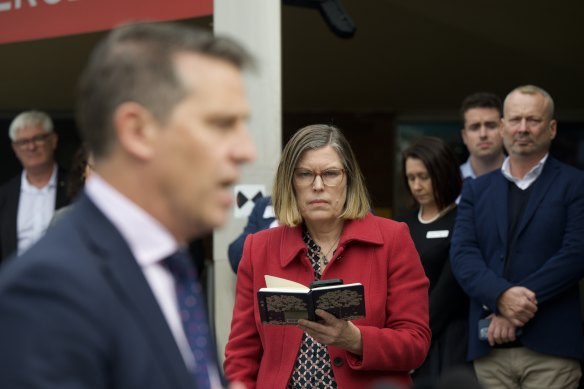This was published 1 year ago
Only one Sydney site monitored for cancer-causing chemicals in drinking water
By Kate Aubusson and Carrie Fellner
Sydney authorities are monitoring just one site for carcinogenic contaminants in the city’s water, as the premier, health minister and chief medico were at pains to stress the safety of our water supply.
Chief Health Officer Dr Kerry Chant confirmed on Tuesday the “forever chemical” PFOA is cancer-causing, in line with the World Health Organisation’s classification but in contrast to the federal government’s denial that they cause “important” health effects.

Dr Kerry Chant and NSW Health Minister Ryan Park at Ryde Hospital on Tuesday.Credit: Nick Moir
Her comments come after an investigation by this masthead revealed drinking water across parts of Sydney, Canberra, Victoria and Queensland contain contaminants perfluorooctanoic acid (PFOA) and perfluorooctane sulfonate (PFOS) that the US Environmental Protection Agency (EPA) warns probably cause cancer with “no safe level of exposure”.
PFOA is permitted in Australia’s tap water at 140 times the maximum level the US will allow. Either PFOA or PFOS have been found in the drinking water of up to 1.8 million Australians since 2010, including the Sydney suburbs of North Richmond, Quakers Hill, Liverpool, Blacktown, Emu Plains and Campbelltown, along with the NSW regional centres of Newcastle, Bathurst, Wagga Wagga, Lithgow, Gundagai and Yass.
NSW Health Minister Ryan Park said on Tuesday he was confident Sydney’s drinking water was safe, echoing Premier Chris Minns’ assertion the city’s supply was “generally considered very good”.
“We’re very fortunate that we have catchments that are largely protected ... but it is something we monitor frequently,” Park said. “My kids drank water out of the tap in the Illawarra this morning … they’ll be drinking it today at school, they’ll be drinking it when they get home.”
The US set new enforceable maximum limits of 4 parts per trillion for PFOS and PFOA – equivalent to four grains on a beach containing a trillion grains of sand – which was the lowest level water supplies could feasibly achieve. It also set a goal level of zero for all providers, warning there was no level of exposure “without a risk of adverse health effects”.
Chant said the water supply of Sydney met the US EPA guidelines, except for one instance in 2019 at North Richmond, where testing found the levels of PFOS exceeded the US maximum but were still below the Australian threshold.
Testing in 2023 and 2024 detected levels below the new US maximum, Chant said.
The water filtration plant at North Richmond is about 13 kilometres upstream from the Royal Australian Air Force base, which is considered a potential source of PFAS contamination for the area.
North Richmond is the only site where Sydney Water tests for the contaminants. Sydney Water’s website states: “We are not currently monitoring drinking water supplies for PFAS except at North Richmond.”
A Sydney Water spokeswoman said in a statement: “There are no known PFAS hotspots in our drinking water catchments.”
The most comprehensive data comes from a federally funded University of Queensland study published in 2011, which sampled 34 locations across the country. Localised surveillance in recent years confirmed the chemicals were still turning up in some of the same locations they were first found in 2011, in some instances at higher concentrations.
In December 2023, the World Health Organisation’s International Agency for Research on Cancer (IARC) upgraded its classification of PFOA from “possibly carcinogenic” to “carcinogenic to humans”.
IARC’s decision was based on “sufficient evidence it can cause cancer in lab animals and strong evidence that it has some of the key properties of a carcinogen in people who are exposed to it”.
Chant confirmed that NSW authorities had adopted the new classification of PFOA as “carcinogenic”, but said the evidence was not conclusive.
“We are exposed every day to a variety of different chemicals. We are exposed to radiation, we are exposed to all sorts of things that impact our health including particulate pollution,” Chant said.
Chant said proportionate efforts were under way to lower exposure, including the phasing out of the use of these chemicals worldwide and reviews of drinking water standards.
The National Health and Medical Research Council – which developed Australia’s Drinking Water Guidelines – is reviewing its guidelines for PFAS in the wake of the overseas developments.
Chant said that depending on the outcome of this review, “We may well move to the same levels [as the US].”
The two chemicals in the spotlight are part of a broader family of per- and polyfluoroalkyl substances (PFAS), best known as “forever chemicals” because they never break down in the environment and linger for years in the human body.
This masthead contacted all 23 affected Australian drinking water providers and they responded that their water is safe because levels detected fall within Australia’s drinking water guidelines. Many exceed the new US safety thresholds, which are based on recent scientific evidence showing forever chemicals are more dangerous than previously understood.
Start the day with a summary of the day’s most important and interesting stories, analysis and insights. Sign up for our Morning Edition newsletter.
clarification
This story has been updated to reflect that either PFOA or PFOS have been found in the drinking water of up to 1.8 million Australians since 2010.